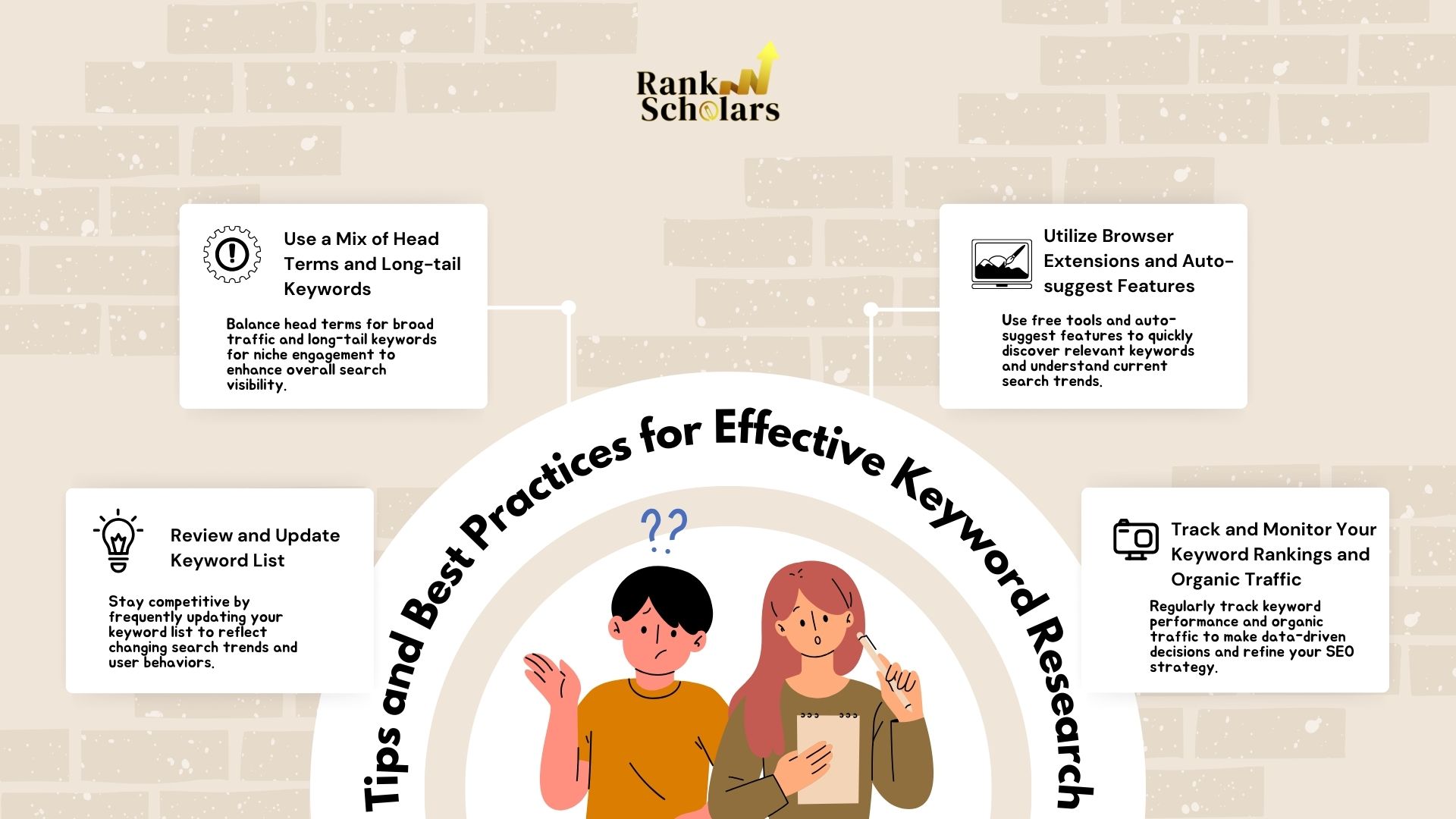Keyword research can be a daunting task, especially when you’re on a budget. Many small businesses and bloggers struggle due to the high costs associated with premium tools that help find the right keywords, essential for driving traffic and improving SEO.
If you’re feeling overwhelmed by the need to boost your website’s visibility without breaking the bank, we have good news for you.
There are several powerful, free tools available that can help you uncover valuable keywords, understand search trends, and optimize & enhance your content’s relevance.
In this blog, we’ll explore how to do keyword research with free tools, giving you the power to compete and succeed without a big investment. Let’s unlock the secrets to smart and cost-effective keyword research

Why Keyword Research is Important for SEO
Keyword research is the backbone of any successful SEO strategy, yet it often feels like an overwhelming puzzle. The frustration of seeing what you thought was a stellar piece of content going unnoticed can be disheartening.
However, the truth is without proper target keywords, your content might as well be invisible to search engines. It’s like shouting into the void, hoping someone will hear.
The problem lies in not understanding what your audience is searching for. Keyword research bridges this gap and helps you to discover & target the exact phrases and terms your potential readers are using.
Without effective keyword research, you might be attracting the wrong audience. This can lead to high bounce rates and low engagement, ultimately hurting your SEO efforts. By identifying and using the right keywords, you ensure your content reaches the right people, those who are genuinely interested in what you have to say.
Keyword research helps you connect with your audience, drive relevant traffic, and improve the rankings of your blog posts in search engine result pages(SERPs). Don’t let your hard work go to waste – invest time in keyword research and see the difference it makes.
Can I Do Keyword Research for FREE?
Absolutely, you can do keyword research for free!
However, there’s a common misconception that effective keyword research requires expensive tools. As a small business owner, freelancer, or blogger who operates on tight budgets, you might have found yourself asking, “How can I find the right keywords when I can’t afford these high-end tools?”
The reality is that effective keyword research doesn’t have to come with a hefty price tag. Free tools can provide valuable insights if you know where to look and how to use them.
Remember, It’s not just about finding keywords, it’s about finding the right keywords that drive relevant traffic and conversions.
There are numerous free keyword research tools available that can help you perform thorough keyword research without costing you a dime. By using these resources, you can uncover high-potential keywords, understand search intent, and stay competitive in your niche.
Best FREE Keyword Research Tools
Finding the right keywords can feel like searching for a needle in a haystack, and that is where free tools come into play. These tools offer a lifeline for those who need powerful insights without breaking the bank.
Following are three of the best free keyword research tools that can help you overcome these challenges and improve your online visibility.
Google Keyword Planner
Google Keyword Planner is a powerful tool offered by Google Ads that helps users find and analyze keywords. It’s designed primarily for advertisers, but it’s also an excellent resource for anyone looking to improve their SEO.
Benefits:
Google Keyword Planner helps you discover new keywords related to your business, see estimates of the searches they receive, and get cost estimates to target them. This tool is beneficial because it provides data directly from Google, ensuring you’re working with the most accurate information available.
How to Use:
- Sign in to your Google Ads account (or create one if you don’t have one).
- Go through the “Tools & Settings” menu and select “Keyword Planner.”
- Choose between “Discover new keywords” or “Get search volume and forecasts.”
- Enter your keywords or URL to generate a related keywords list and their metrics.
Key Feature:
This tool can access comprehensive keyword data directly from Google. This feature provides you with the actual search volumes, competition levels, and trends, making it easier to choose the right keywords to target.
It’s like having insider information straight from the source, giving you a significant competitive advantage.
Keyword Surfer
Keyword Surfer is an incredibly efficient tool for generating keywords. It is a free browser extension that provides real-time keyword data as you perform Google searches. This tool saves you time by integrating keyword research into your regular browsing experience.
Benefits:
With Keyword Surfer, you gain valuable insights such as search volume, cost-per-click (CPC), keyword suggestions, related terms, visibility metrics, and on-page data, all without needing to switch between multiple tools.
It’s particularly beneficial for those who need immediate keyword insights while browsing, saving time and streamlining the research process.
How to Use:
- Install the Keyword Surfer extension from the Chrome Web Store.
- Conduct a Google search as you normally would.
- View the keyword metrics that appear on the right side of your search results, including search volume and related keywords.
Key Feature:
The standout feature of Keyword Surfer is its ability to provide real-time keyword data directly on the Google search results page. This feature allows you to seamlessly integrate keyword research into your daily browsing activities, providing valuable data without disrupting your workflow.
WordStream’s Free Keyword Tool
WordStream’s Free Keyword Tool is designed to help users find valuable keyword suggestions tailored to their industry. It offers a straightforward and user-friendly interface, making it accessible to anyone, even those new to SEO.
Benefits:
This tool generates keyword suggestions based on your input and provides relevant metrics such as search volume and competition level. It’s beneficial because it offers industry-specific keyword data, ensuring the results are highly relevant to your business.
How to Use:
- Go to WordStream’s Free Keyword Tool website.
- Enter a keyword related to your business or industry.
- Select your industry and country to get more specific results.
- Review the list of keyword suggestions and their associated metrics.
Key Feature:
The main feature is its industry-specific keyword suggestions. By tailoring the results to your particular field, WordStream ensures you get the most relevant and actionable keywords for your niche.
This targeted approach means you’re not sifting through irrelevant data, allowing you to focus on the keywords that matter most to your audience and business.

Step-by-step Process of Keyword Research
Now that you know what free tools you can use, you might wonder where you should begin. Below is a step-by-step process that helps you unlock the potential of these tools with some actionable tips.
Define Your Goals and Target Audience
Before diving into keyword research, you must define your objectives and understand your target audience.
Many find it difficult to pinpoint the right keywords because they haven’t clearly outlined their goals or identified their audience’s needs. Without this clarity, you risk targeting keywords that don’t align with your business objectives or resonate with your audience.
Are you looking to increase brand awareness, drive conversions, or boost website traffic? Who is your ideal customer, and what are their pain points and interests?
By answering these questions, you can narrow down your focus and tailor your keyword research efforts to align with your objectives and you’ll set a solid foundation for effective keyword research.
Generate Seed Keywords
Seed keywords are the foundation of your keyword research efforts. They act as the starting point from which you’ll expand your list of potential keywords.
You can start by brainstorming a list of relevant topics and terms related to your niche or industry. Put yourself in your audience’s shoes, what would they search for?
Utilize your industry knowledge, customer insights, and competitor analysis to compile a list of initial keywords. These seeds will serve as the roots from which you’ll grow your keyword list.
Without a list of seed keywords, your subsequent research may lack depth and relevancy. This process helps streamline your research efforts and ensures that the keywords you target are aligned with your audience’s interests and search behavior, setting the stage for successful SEO optimization.
Use Keyword Research Tools to Expand Your List
Using keyword research tools is like uncovering your hidden treasures. These tools act as your compass, guiding you toward keywords that hold the key to unlocking your content’s full potential.
When you leverage free tools like Google Keyword Planner or AnswerThePublic, you can expand your list of potential keywords with ease. With these tools, you can explore related keywords, long-tail variations, and trending topics, empowering you to diversify your keyword strategy and stay ahead of the competition.
By understanding your specific needs and exploring different tools, you can find the ones that best suit your requirements without breaking the bank.
Analyze Search Volumes and Competition Levels
It’s important to understand which keywords are worth pursuing and which ones are too competitive to use in your content. Analyzing search volumes and competition levels is a vital step in keyword research, determining the viability and potential impact of chosen keywords.
Search volume indicates how frequently a particular keyword is searched, providing insight into its popularity and potential traffic generation.
High search volume suggests greater user interest but also increased competition. Conversely, low search volume may signify limited interest or niche topics with less competition.
Balancing search volume and competition is key, targeting highly competitive keywords can be challenging for new websites, while low-competition keywords may offer easier ranking opportunities but potentially lower traffic.
By analyzing these metrics, you can strategically prioritize keywords that offer the best balance for your content strategy.

Important Keyword Metrics and Data
Keyword research isn’t just about finding relevant words or phrases, it’s about understanding the data behind them. Following are some metrics and data points you need to consider for effective keyword research.
Search Volume and Monthly Searches
Search volume refers to the number of times a keyword is searched for within a specific time frame, usually known as monthly search volumes. It gives you insight into the popularity and demand for a particular keyword.
By analyzing search volume, you can prioritize keywords that have a higher potential to attract traffic to your website or content. Free tools like Google Keyword Planner or Ubersuggest provide search volume data, allowing you to identify keywords with sufficient demand for your content.
Without this information, you might end up targeting keywords that simply don’t have enough interest from users. By prioritizing keywords with sufficient search volume and consistent monthly searches, you can optimize your content for maximum visibility and engagement.
Keyword Difficulty
Keyword difficulty is a persistent challenge for marketers and content creators alike. You might have encountered this frustration when trying to rank for competitive keywords within your niche.
Keyword difficulty measures the competitiveness of a keyword with ranking on search engine results pages. It takes into account various factors, including the authority of websites already ranking for the keyword, the quality and quantity of backlinks they have, and the overall content strength.
By leveraging keyword difficulty data, you can discover less competitive long-tail keywords or niche topics where you have a better chance of ranking higher. Free tools like Moz’s Keyword Explorer or SEMrush offer keyword difficulty scores, typically ranging from 0 to 100, with higher scores indicating higher difficulty.
Organic CTR (Click-Through Rate)
Organic click-through rate (CTR) measures the percentage of users who click on your website’s link when it appears in search engine results. It’s a key indicator of how appealing your content is to users and how well it resonates with their search intent.
A low organic CTR indicates that your title tags and meta descriptions may not be compelling enough to attract clicks. Improving your organic CTR starts with optimizing your title tags and meta descriptions. Also, analyzing SERP features such as featured snippets, knowledge panels, and related questions can provide insights into user intent and behavior.
While free tools may not provide specific organic CTR data, you can monitor changes in your website’s performance in search results using tools like Google Search Console.
Tracking your organic CTR over time and experimenting with different title tags and meta descriptions can help you identify what resonates best with your target audience and optimize your content for maximum visibility and engagement.
Using Keyword Research to Inform Your Content Strategy
Understanding the language your audience uses, the topics they’re interested in, and the intent behind their searches can make all the difference in crafting relevant content. But how do you ensure your content is hitting the mark? Let’s find out.
Selecting Valuable Keywords with Commercial Intent
Selecting valuable keywords with commercial intent can help you drive meaningful traffic and conversions. Commercial intent keywords target a user’s readiness to purchase or take specific actions, such as signing up for a newsletter or requesting a quote.
These keywords attract visitors further along in the buyer’s journey, increasing the likelihood of conversions. Using free keyword research tools provides invaluable insights offering data on search volume, competition, and trends to pinpoint commercial potential.
Tools like Google Trends further refine your understanding of how these keywords are used, allowing you to tailor content to meet specific audience needs.
With high-intent keywords, you can create targeted content that addresses queries and concerns, and this strategic approach ensures that your content resonates with high-intent users, boosting visibility and profitability.
Creating Content Around Long-tail and Question-based Keywords
Creating content around long-tail and question-based keywords is a strategic approach that can significantly enhance your visibility and engagement.
Long-tail keywords, which are more specific and often longer phrases, may have lower search volumes but come with higher intent and less competition. These keywords allow you to tap into niche markets and address specific queries that your audience is actively searching for.
Similarly, question-based keywords, which often start with “how,” “what,” “why,” or “where,” reflect the exact questions potential customers are asking. These keywords can drive traffic that is not only interested in the general topic but is also looking for detailed, actionable information.
By focusing on long-tail and question-based keywords, you can create content that directly addresses your audience’s unique needs and pain points, establishing your authority in your niche.
Grouping Keywords into Clusters for SEO Optimization
Keyword clustering offers a strategic solution to group related keywords into clusters based on their semantic similarity and you can create comprehensive content that covers a topic holistically.
This approach not only improves the structure of your site but also signals to search engines that your content is thorough and authoritative. Free keyword research tools make this task more manageable by automating the clustering process. These tools help you identify patterns and relationships within your keyword data, enabling you to build cohesive content silos.
For instance, if you’re focusing on the topic of digital marketing, you might cluster keywords around subtopics like SEO, social media marketing, and content marketing.
Effective keyword clustering can transform a chaotic keyword list into a powerful, optimized content strategy, driving better search engine rankings and improved user engagement.
Analyzing Keyword Competition and Opportunities
Understanding keyword competition and identifying opportunities helps you improve your search engine rankings and drive more traffic to your website. It’s not just about finding keywords, it’s about finding the right keywords that can give you a competitive edge.
Conducting Competitive Keyword Gap Analysis
Conducting a competitive keyword gap analysis is a great strategy to outperform your competitors in search engine rankings. This analysis involves identifying the keywords your competitors rank for that you do not, highlighting gaps in your content strategy.
The process begins by compiling a list of your top competitors and analyzing their keyword performance. The free tools allow you to compare their keyword rankings with your own, revealing which keywords drive traffic to their sites that you might be overlooking.
This insight is crucial, as it enables you to identify high-potential keywords that you can target to close the gap. For example, if a competitor ranks highly for specific long-tail keywords that are relevant to your content but missing from your strategy, you can create targeted content to address this gap.
Conducting a competitive keyword gap analysis is a powerful way to identify missed opportunities, refine your content strategy, and improve your overall SEO performance without the need for expensive tools.
Identifying Breakout Keywords and Underperforming Keywords
Breakout keywords are those that are rapidly gaining popularity, often driven by current events, emerging trends, or shifts in consumer behavior. By identifying these keywords early, you can create or update content to capture this rising interest, positioning your site as a timely and relevant resource.
On the other hand, recognizing underperforming keywords allows you to take a proactive approach to content optimization. These are keywords that you may have previously targeted but are no longer yielding the desired results.
Using tools such as Google Search Console, you can analyze which keywords are underperforming by examining metrics like click-through rates, impressions, and average positions.
By continuously monitoring both breakout and underperforming keywords, you can ensure that your content strategy remains dynamic and responsive to changing search behaviors. This dual approach not only helps in capturing new opportunities but also in maximizing the value of your existing content.
Leveraging Keyword Opportunities for SEO Growth
This process involves more than just identifying high-potential keywords, it requires a strategic approach to integrate these keywords into your content in a way that maximizes your SEO efforts.
Free tools like Keyword Surfer, Moz’s free keyword explorer, and Google’s Keyword Planner can help you identify long-tail keywords and niche terms that are less competitive but highly relevant to your audience.
By focusing on these specific keywords, you can target smaller, more defined segments of your industry, which often results in higher conversion rates. Using these tools allows you to understand the search intent behind the keywords, enabling you to create content that precisely meets the needs of your audience.
By prioritizing keywords that align with your business goals and audience needs, you can ensure sustainable SEO growth.

Also Read: Top 15 Low-competition Niches for Blogs in 2024
Tips and Best Practices for Effective Keyword Research
Keyword research is more than just a one-time task, it’s an ongoing process that requires strategic thinking and constant updating. To maximize your SEO efforts and drive organic traffic, you need an approach that includes various techniques and tools.
Regularly Review and Update Your Keyword List
One of the effective SEO strategies is to regularly review and update your keyword list because search trends and user behaviors are constantly changing, which means that the keywords driving traffic to your site today may not be as effective tomorrow.
By consistently evaluating your keyword performance data, you can identify which terms are continuing to deliver results and which ones have lost their relevance. This process allows you to phase out underperforming keywords and incorporate new, high-potential terms that align with current trends.
Also, regular updates to your keyword list help you stay competitive, ensuring your content remains visible and engaging to your target audience. Making keyword review a routine part of your strategy is essential for adapting to market changes and sustaining long-term SEO success.
Use a Mix of Head Terms and Long-tail Keywords
Focusing only on popular, high-traffic keywords, also known as head terms, can be tempting because they seem to promise a large influx of visitors. However, the reality is that these keywords often come with intense competition, making it challenging for smaller sites to rank highly.
On the other hand, targeting only long-tail keywords, which are more specific and less frequently searched, can limit your overall reach despite attracting a more engaged audience.
The key to a successful keyword strategy lies in using a balanced mix of both head terms and long-tail keywords. Head terms help capture broad interest and drive substantial traffic, while long-tail keywords attract niche audiences who are more likely to convert.
This approach not only improves your chances of ranking for various search queries but also ensures you cover different stages of the customer journey.
Utilize Browser Extensions and Auto-suggest Features
Finding the right keywords can be a time-consuming and challenging task, especially when you’re working with limited resources. Fortunately, free tools like browser extensions and auto-suggest features can significantly simplify the process.
Browser extensions such as Keywords Everywhere or Ubersuggest provide instant keyword data as you browse, making it easier to discover new keywords and analyze their potential directly within your search environment.
Auto-suggest features on search engines like Google or YouTube also offer real-time insights into what users are searching for, giving you valuable keyword ideas based on user queries. When you start typing a search term, these platforms automatically suggest related searches, reflecting current trends and popular topics.
This not only helps you find new keywords but also provides a glimpse into the language and phrasing your target audience is using, which can be incredibly useful for creating content that resonates with them.
Track and Monitor Your Keyword Rankings and Organic Traffic
Without regular monitoring, it’s challenging to understand why your content isn’t reaching its full potential. By using free tools you can gain valuable insights into how your keywords are performing, identify traffic patterns, and understand user behavior.
These tools allow you to see which keywords are driving traffic to your site, how your rankings are fluctuating over time, and how users interact with your content once they arrive. This data helps you pinpoint successful strategies and areas that need improvement, enabling you to make data-driven decisions.
Regularly tracking and monitoring keyword rankings and organic traffic also enables you to measure the effectiveness of any SEO changes or optimizations you implement. Whether you’re tweaking meta tags, refining on-page content, or building backlinks, tracking changes in keyword rankings and organic traffic allows you to assess the impact of these actions in real time.

Final Words
With a plethora of tools being available, how to do keyword research with free tools is the real question. In this blog, we’ve discussed thoroughly about using these tools and how implementing best practices, and maintaining a diligent monitoring system can help you unlock valuable insights into user behavior, optimize your content for search engines, and stay ahead of the competition.
Remember, keyword research is not a one-time task but an ongoing process that requires adaptability and persistence. With dedication and strategic planning, you can unlock the potential of your content, attract more organic traffic, and propel your online presence to new heights. The journey to keyword mastery begins now—happy researching!
Also, if you find it too complex to implement or don’t have the time to, don’t hesitate to contact us for your SEO & content marketing needs.

Sahanaj is a content writer who is passionate about turning ideas into words that inspire positive change.


